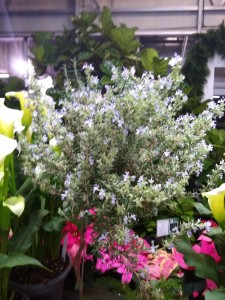 Merchandisers are under a lot of pressure every year to introduce new and/or different plants for the holidays. Troll the aisles of nurseries and garden centers right now and you will see new and different poinsettias, bodacious kalanchoes and even hellebores for indoor display. Novelty piques interest.
Merchandisers are under a lot of pressure every year to introduce new and/or different plants for the holidays. Troll the aisles of nurseries and garden centers right now and you will see new and different poinsettias, bodacious kalanchoes and even hellebores for indoor display. Novelty piques interest.
I am a jaded horticulture consumer, so piquing my interest is difficult. Still, I am very attracted to the increased number of herbal topiaries available for holiday purchase. This year I am seeing lots of rosemary topiaries, which I find especially attractive. When I look at the shrubby little rosemary currently residing in my sunny foyer window, I begin to have thoughts of disciplining it into tree form, just to keep up with current fashion.
Those of us who are fond of cooking probably have a little jar of dried rosemary in our spice racks. Those of us who aspire to somewhat greater culinary heights may have some fresh rosemary in the crisper drawer. Not many of us grow the live item in our gardens or, for cold climate dwellers, in our houses for the winter. Clearly the garden merchandisers think it is time for us to reconsider.
Rosemary or Rosmarinus officianalis is a member of the enormous mint or Lamiaceae family. It is a small shrub, closely related to lavender, Russian sage and other salvias. Hailing from the Mediterranean, its fragrant leaves and stems have been used for culinary, medicinal and cosmetic purposes for centuries. Most of us don’t need “strewing herbs” now, but back in the days when dirt floors were covered with increasingly rancid straw, a sprinkling of rosemary underfoot helped make indoor environments more tolerable. Easy to dry and store, rosemary has been used internally and externally over the centuries to cure everything from bad digestion to eczema. One ancient herbal even recommended regular exposure to the pungent scent of “the wood of rosemary” to prolong and preserve youthful vigor.
Rosemary is happiest in warm weather climates, where it can enjoy full sun, moderate to dry soil and good drainage. Under those conditions, it can grow two to six feet tall and two to four feet wide. When June or July rolls around, a healthy plant will produce lots of white to blue blossoms that attract pollinators and appreciative glances. In California’s Gold Rush country I once saw prostrate rosemary plants growing over a stone wall, sprinkling blooms like stars against the gray stone background. Fittingly that display was in front of a VFW hall, where the rosemary fulfilled one of its other traditional roles—as the herb of remembrance. Shakespeare marks this in Hamlet, when Ophelia says, “There’s rosemary, that’s for remembering.”
I can provide everything that rosemary likes, except the warm weather climate. That is why my plant, which flourished and bloomed last summer, is currently resident indoors. I don’t have a warm greenhouse or a sophisticated array of plant lights, so I have to stay vigilant if my rosemary is to survive until it can go outdoors in spring. If you are in the same situation now, or receive one of those lovely rosemary topiaries as a holiday gift, provide it with as much light as you can. Supplemental light—even that provided by ordinary light bulbs—will help. Turn the plant every few days to promote even growth, and honor the herb of remembrance by remembering not to kill it with the kindness of overwatering.
Making a topiary is not hard—it just takes a bit of clipping and a modicum of patience. If you can, pick a young specimen with a single strong stem. Clip off any branching stems on the lower two thirds of the plant. Trim the top growth into a rounded shape. Stake the rosemary so that it grows straight and monitor its progress, removing lower side stems and continuing to shape the top. Your topiary will get better and better over time, as long as its other cultural requirements are met.
If you are lucky enough to receive a ready-made rosemary topiary, all you have to do is enjoy its beauty and fragrance, and discipline its growth to maintain the shape. When you clip shoots, use the leaves right away in recipes, or air-dry them for future use. Herbs that you grow yourself seem to taste better than even the freshest store-bought specimens.
I should add that if someone gives you last year’s topiary of choice—lavender—you can treat it in the same way as rosemary. This will keep you in practice for next year, when some new variety of herbal topiary will inevitably take center stage.
